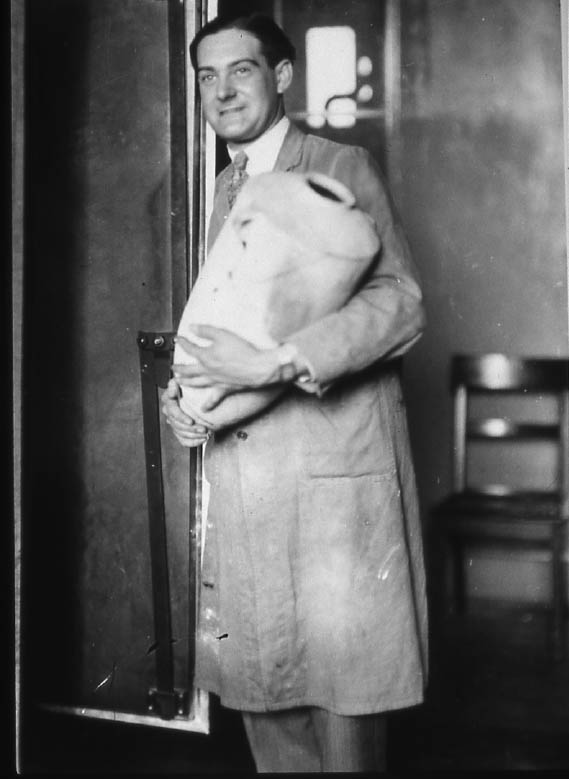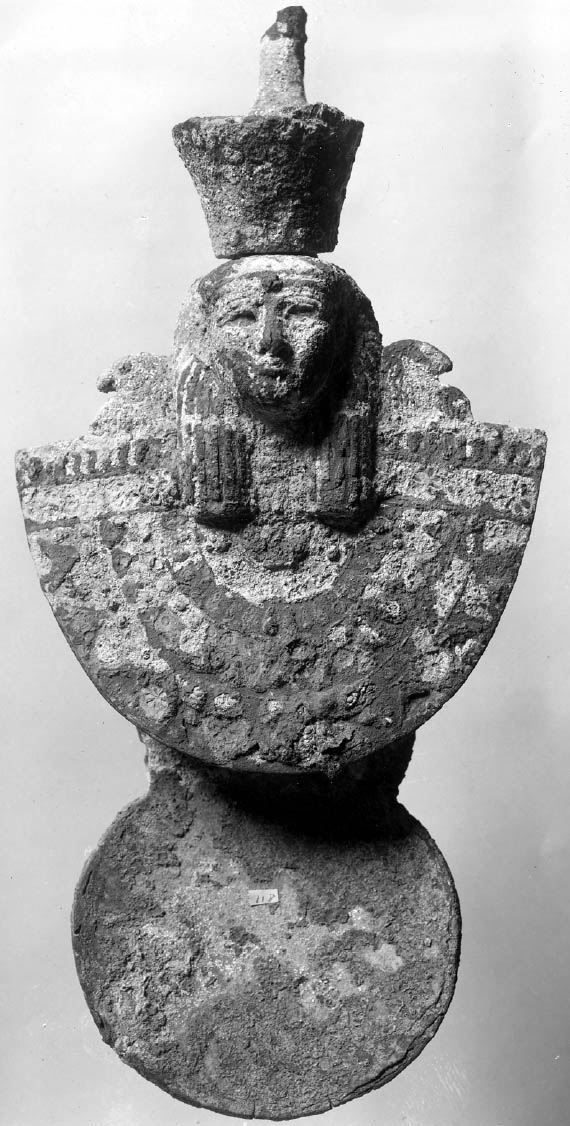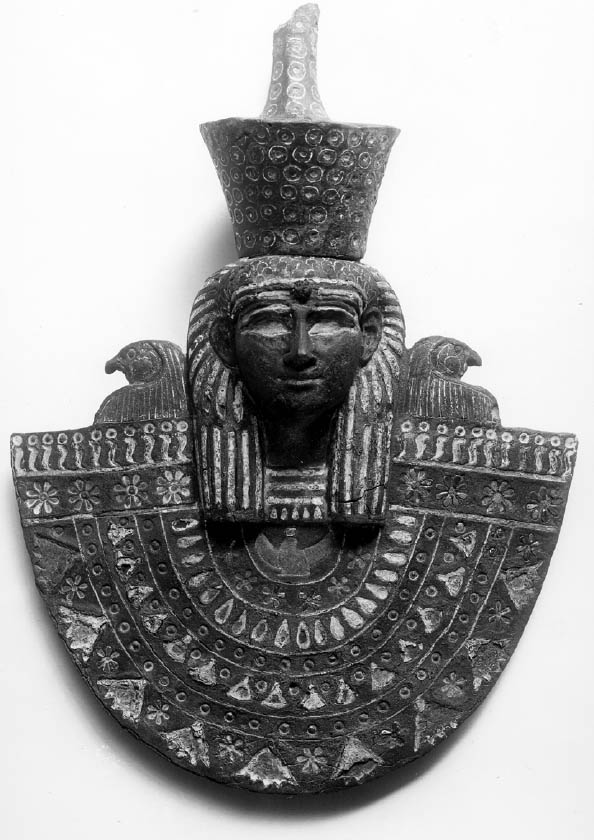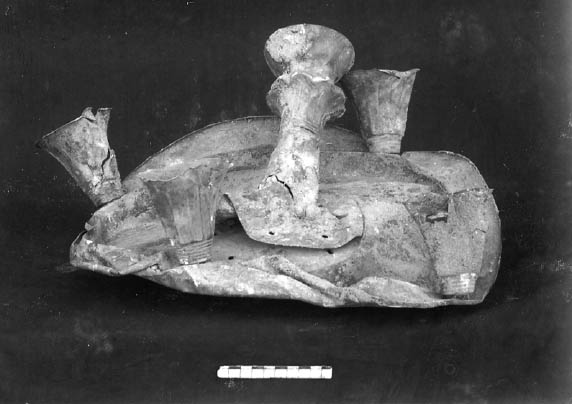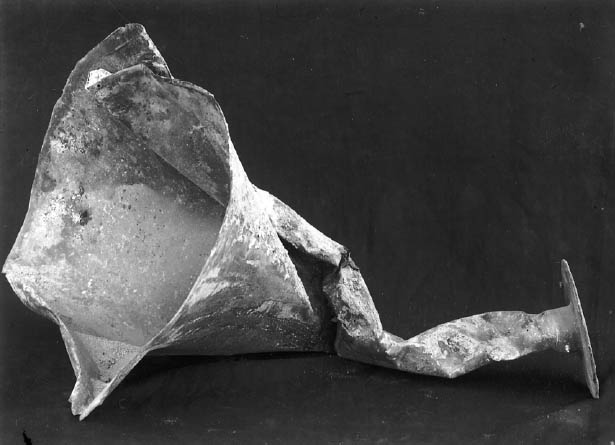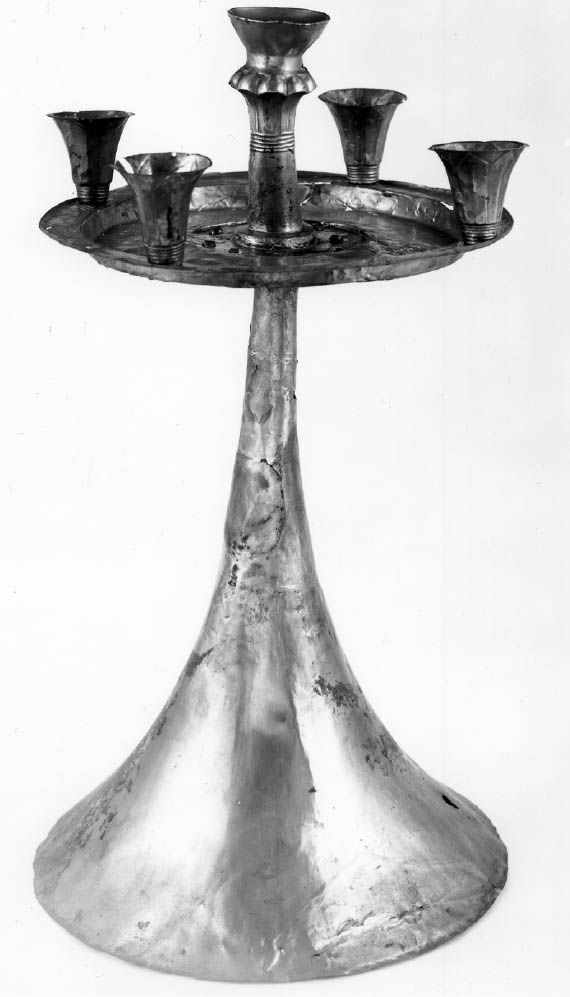THE ANCIENT EGYPTIAN COLLECTION AT THE MUSEUM OF FINE ARTS, BOSTON. PART 2, A REVIEW OF FORMER TREATMENTS AT THE MFA AND THEIR CONSEQUENCESSUSANNE G�NSICKE, PAMELA HATCHFIELD, ABIGAIL HYKIN, MARIE SVOBODA, & C. MEI-AN TSU
4 METALS4.1 CLEANING AND REDUCTIONThe history of the treatment of Egyptian metal objects at the MFA is tied to electrolytic reduction. Many objects in the collection have been cleaned by such a procedure. The condition of objects cleaned in this fashion is often described in later treatment reports as being metallic, granular, pitted, etched and/or scratched, or smooth and without corrosion products. In some cases it is noted that uneven corrosion products remain. Of the 139 object files for copper and bronze objects reviewed for this article, only 12 pieces were noted to retain original corrosion products, burial accretions, or pseudomorphs.
One of the earliest treatments, published in the MFA Bulletin in 1931, is that of the 22d Dynasty
The MFA Bulletin article described the materials and the method of fabrication, but did not elaborate on the treatment. It was noted that a gilded silver inlay of a winged figure “was found so badly oxidized that it could not be preserved” (Dunham 1931, 109), and indeed this inlay is missing today. The treatment record for the object states simply: “The object was cleaned by electrolysis.” Young later presented his treatment of the Aegis in lectures and articles where, citing the work of earlier chemists Adolf Finkener, Friedrich Rathgen, and Colin Fink, he described the reduction of ancient metals. The procedure was as follows:
Young also mentioned the use of iron, nickel, and platinum anodes. When the reduction was completed, the object was “removed from the bath, soaked in several changes of hot water to remove all traces of caustic soda, followed by drying in an oven at 40 to 60 degrees centigrade” (Young 1963, 6). This method was passed on to Nichols. Electrolytic reduction continued to be used for the treatment of copper and its alloys, silver, gilded silver, electrum, lead, and iron until the early 1980s. For the reduction of silver, Nichols's notes and instructions expand upon the basic method outlined above. Before reduction was undertaken, an object might be examined with x-radiography, ultraviolet illumination, or metallographic sections to determine the presence of core metal and check for ancient or modern restorations. The object would undergo prolonged soaking in a series of solvents (toluene, hot water, alcohol, and acetone), and coatings, restoration materials, and any material from burial that would interfere with conductivity were mechanically removed. Lead-tin or zinc-tin solder repairs were removed with a soldering iron. The object was then soaked in a bath of 2% sodium hydroxide to remove remnants of organic matter and to raise the pH of the silver (Nichols noted that this bath will also dissolve silver chloride and cautioned that the object may turn to mud if totally corroded). Finally, various mixtures of hydrochloric and formic acids were used to remove calcite accretions and to increase the For tank reduction, fragile objects might be supported on a bronze screen. For local reduction of silver, the cathode was a graphite rod. The anode was a sponge pierced with a graphite rod and immersed in the electrolyte. Two anode sponges would be used, one containing sodium bicarbonate (to remove silver sulfide), the other containing 2% sodium hydroxide (to remove silver chloride and to “harden” the corrosion material for removal with a scalpel). After these steps were repeated, the current was reversed to oxidize the silver, turning it black, at which point the black surface would be cleaned with ethanolamine on cotton swabs to remove redeposited copper oxides, carbon, and grease. The procedure was repeated several times, along with brushing under hot running water and the use of a scalpel. Finally, the piece was “electro-polished” using sodium bicarbonate paste and soaked in distilled water until the pH was neutralized (Nichols n.d.). Object files mention removal of redeposited copper with ethanolamine, as mentioned above. Redeposited copper was also disguised by bronzing with sodium hydroxide paste and iron oxide or removed using ammonium carbonate and wooden tools. One of the primary reasons for the early stripping of bronzes was to rid them of chloride that causes bronze disease (Beale 1996). MFA records also state the following goals: to remove corrosion, to allow reshaping and reforming, and to reveal inscriptions. By the early 1980s notes in files begin to reflect ethical conflicts with such treatments, and reduction is now rarely used at the MFA. Its use on Egyptian artifacts in recent years has been restricted to local reduction using formic acid and aluminum foil for removal of remains of corrosion products from previously reduced objects. Metals that have been reduced or stripped have often required re-treatment in later years due to tarnishing or corrosion of reactive, bright metal and the removal or renewal of protective coatings (discussed in sec. 4.7). Another problem that has been noted with a few chemically cleaned objects is corrosion connected with residual chemicals leaching out of the metal. 4.2 BRONZE DISEASEForty years after the initial treatment of the Aegis of Isis, it was treated for bronze disease. The worksheet states: “SOP bronze disease” and lists the locations of the bronze disease but gives no description of the treatment. Young's preferred treatment of bronze disease was a solution of silver nitrate, which he fixed in place with heat (Beale 1996). And indeed as late as 1983 areas of bronze disease were treated on another Egyptian bronze object by excavating the corrosion pits with a needle and applying silver nitrate solution, although no mention was made of using heat. Nichols's “Standard Operating Procedure” may refer to his mentor's methods, or he may have used other techniques. Benzotriazole as a treatment for bronze disease first appears in object files in 1986, but it may have been in use at the MFA much earlier. Benzotriazole is currently the standard treatment for bronze disease at the MFA, often in combination with a pretreatment with sodium carbonate, followed by coating with Paraloid B-72 (formerly Acryloid B-72), and a recommendation that the object be stored and displayed in a desiccated environment. Silver oxide paste has also been used on objects with organic elements. The Aegis was reexamined for a reinstallation in 2001 and found to be in good and stable condition. 4.3 OTHER METHODS OF CLEANINGMetal artifacts were also cleaned mechanically with glass brushes, brass scratch brushes, a scalpel, or wooden tools. Mirrors and knife blades were routinely polished with a succession of wet abrasives from 320-grit silicon carbide sandpaper to 0.05 μm alumina powder. Not surprisingly, later condition reports note that the surfaces are covered with fine scratches, some discolored. Silver objects in the Egyptian Collection have also been cleaned with 5% ammonia;with 5% or 10% nitric acid, or with 5% sulfuric acid. Nichols's recipe file includes a solution of Orvus detergent (2 g) and Calgon (0.5 g) in water (1:1) for cleaning metals, although no reference to this solution's being used on the Egyptian Collection has been found. 4.4 RESHAPING, REFORMING, AND REPAIRSDuring excavation in the Sudan in 1919, the 25th Dynasty bronze offering table of King Piye (MFA 21.3238) was found crushed in a stairway where it had fallen during an ancient plundering of the tomb (figs. 6, 7; Dunham 1950). The treatment of this object was often cited by Young and others (fig. 8; Young n.d., 1958; Dunham 1958). The curator described the treatment to “restore the parts to their original forms by repeated shaping and annealing. A few places where the metal had been corroded away have been patched with new material and one of the rim-cups is a modern copy; but in all other respects the piece is original” (Dunham 1958, 99).
Excavation photographs show all four rim cups, and it is uncertain why one needed to be replaced. Young wrote that reduction was necessary before the piece could be annealed and reshaped (Young n.d.). Repairs were made with solder, and the base was supported with an internal armature of thick copper wire. The piece was coated after treatment (see sec. 4.7 for a discussion of coatings). Gold and silver objects were also annealed and reshaped. The surfaces would then be polished to 0.3 μm alumina to remove annealing discoloration. One object treated in this fashion in 1981 is a 2d Dynasty
Solder repairs have been found on the offering table mentioned above as well as on some other bronze and gold pieces from the Sudan. In some cases, such as a set of gilded silver cylinder sheaths from Nuri (two examples are MFA 20.275, 21.11742; G�nsicke and Newman 2000), modern solder repairs extend over original decorative surfaces. Shellac, plaster, and unidentified water-soluble white adhesives have also been found on copper and bronze objects. Nichols's reports from the 1970s and 1980s commonly mention repairs done with Elmer's Glue-All, often with a backing of thick mulberry paper. Losses were filled with a mixture of Elmer's Glue-All, mulberry paper, and Rapidstone. Linen was sometimes used in place of paper as a backing. Repairs were also made with epoxy and aluminum powder. Plaster fills have also been found on objects, although there is no written documentation of plaster being used. Polyvinyl acetate resin (PVAC) was used as a coating and an adhesive in the 1980s and probably earlier. Corrosion associated with old repairs has been one reason for retreatment. Turquoise, green, and blue corrosion products found adjacent to old repairs on copper and bronze objects have been mechanically removed. Although the adhesives have not been identified, analysis of some of these corrosion products has found formate and acetate salts. Current practice is for repairs and fills to be made with acrylic adhesives, usually Paraloid B-72 or B-48N, often in combination with glass microballoons, cellulose powder, and/or lens tissue. Methylcellulose has been used to secure lifting gilding. 4.5 REPATINATIONThe stripped surfaces of copper alloy artifacts that had been treated by reduction apparently required repatination in at least some instances, although there is no written documentation in the files about repatination. The even, dark coloration on a figure of Sekhmet (MFA 86.246) and patches of bright yellow-green in pits below the original surface on a bronze foot (MFA 24.896) suggest that these pieces have been chemically repatinated. Comparison of the current appearances of objects with curatorial requests provides other indirect evidence that such procedures were sometimes carried out. Regarding a bronze knife (MFA 20.1799), a 1977 request was: “Please clean to restore as closely to the original color as possible.” The knife now has a bare metal surface that would not seem to have been repatinated after stripping. Regarding a bronze bell (MFA 24.857), a 1979 request states:“Clean and repatinate.” The bell currently has an even black surface, suggesting that it was indeed repatinated. Toning down stripped surfaces without chemical repatination was done with the application of jewelers' rouge over the stripped surface of a copper jug (MFA 01.7312) and with “metallurgical Fe2O3 and PVA,” following highlights of silver on some plaque reliefs (MFA 24.1062, 24.1065). Nichols's recipe file includes instructions for toning down overcleaned silver coins with 5% silver nitrate and heat, although this procedure does not seem to have been used on the Egyptian Collection. 4.6 INPAINTINGEarly treatment reports mention inpainting with shellac and dry pigments, PVAC and dry pigments, as well as with bronze powder, silver conductor paint, Aquadag silver contact paint, or a combination of those. Talc has been found in recesses of objects, presumably to enhance contrasts of designs, and whiting has been used for the same purpose. Acrylic emulsion paints have been the primary inpainting media for toning fills since the 1980s. In recent documentation, no instances have been found of inpainting on metals themselves. 4.7 COATINGSMost of the metal artifacts that have been retreated were previously coated and these coatings were often pigmented. In 1999 ceresine wax and beeswax coatings were identified and removed from copper vessels from the 6th Dynasty tomb of Impy mentioned in Part 1 of this article (G�nsicke et al. 2003). PVAC was widely used as a coating for metals up A review of treatment records has shown that coatings (likely to be PVAC, but generally not identified) frequently had to be removed within 10 years of application. Reactive, reduced metal surfaces often tarnished unevenly through coatings, due either to uneven application or to disruption or breakdown of the coating. Such cases necessitated further cleaning of the surfaces, either with ethanol on cotton swabs or with abrasives such as precipitated chalk. In some instances, such as with the offering table of King Piye discussed above, we have chosen not to recoat an object rather than to risk further uneven corrosion. 4.8 MODERN CORROSIONWhen the Aegis of Isis was treated in 1972 Nichols wrote: “Suspect the very start of black disease.” This is a reference to copper sulfide corrosion that would have been caused by exposure to sulfide gases in storage or on display, as mentioned above, and which occasionally can be observed on other bronzes in the collection. The corrosion on the Aegis does not seem to have worsened since then. Red coloration or reddish surface films have been noted on some gold artifacts, which has been identified as gold silver sulfide in some cases. (See Frantz and Schorsch 1990 for a discussion of red gold.) Tarnishing of silver continues to be a problem in some of the galleries. Other corrosion induced by the storage or display materials includes formates and acetates found on a group of copper objects in 1993. Basic lead carbonates have been found on lead objects. These have usually been removed mechanically and with the aid of solvents. 4.9 REPRODUCTIONSReproductions have been made to represent some fragmentary objects. An electrotype or electroform of one of the silver Heterpheres bracelets, made by Young in 1947, shows the complete object and has itself become an accessioned object (MFA 52.1837), although some aspects of the reconstruction are now known to be incorrect. Molds have also been taken and electrotypes made for replacement of missing elements. Silver claws on a set of anklets from the Middle Kingdom (MFA 21.984–.85) “were too fragile to restore, and Mr. Young, the MFA's expert in such matters, made electrotypes from a cut-down mold of the larger pendants, and these were substituted in the present stringing” (Eaton 1941, 97). Finally, a number of molds were taken of objects in the Egyptian Collection for reproduction for sale in the museum shop and in some instances for the private use of friends or scholars of the Egyptian Department. |
